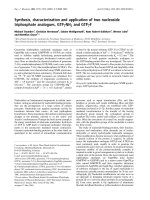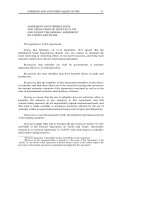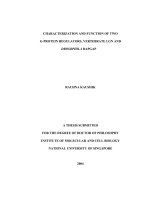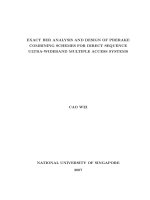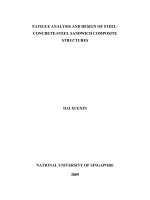Analysis and application of two phase spindle motor driven by sensorless BLDC mode
Bạn đang xem bản rút gọn của tài liệu. Xem và tải ngay bản đầy đủ của tài liệu tại đây (3.8 MB, 112 trang )
ANALYSIS AND APPLICATION OF TWO-PHASE SPINDLE
MOTOR DRIVEN BY SENSORLESS BLDC MODE
WEI TAILE
NATIONAL UNIVERSITY OF SINGAPORE
2004
ANALYSIS AND APPLICATION OF TWO-PHASE SPINDLE
MOTOR DRIVEN BY SENSORLESS BLDC MODE
WEI TAILE
(B. Eng., Huazhong Univ. of Sci. and Tech.)
A THESIS SUBMITTED
FOR THE DEGREE OF MASTER OF ENGINEERING
DEPARTMENT OF ELECTRICAL AND COMPUTER ENGINEERING
NATIONAL UNIVERSITY OF SINGAPORE
2004
Acknowledgement
I am sincerely grateful to my supervisor Dr. Bi Chao for his guidance and support
through these two years when I was in DSI. His abundant knowledge and unmatched
wisdom always amazed me. Without Dr. Bi’s insightful advice and excellent judgment,
this thesis would not be possible.
I cannot be thankful enough to my co-supervisor Dr. Jiang Quan for his timely help
and strong support on my research work. His rigorous attitude to do the research and
inspiring thinking to solve problems are invaluable for my future professional career.
I would like to express my heartfelt thanks to Mr. Lim Choon Pio for his unselfish
assistance and warmhearted help on introducing hardware knowledge to me and giving
a necessary direction to my research.
Furthermore, I would like to appreciate my fellow graduate students as well as my
friends in DSI. They are Lin Song, Wu Dezheng, Huang Ruoyu, Meng Bin, Wu
Daowei, and Chen Li. The friendship between us is a big treasure to me. Their
hardworking, sharing, and self-motivate affected me a lot. Here, I am especially
grateful to Lin Song for treating me to frequent discussions on research problems.
Last, but not least, I would like to thank my parents. Without their continuous
encourage and support, this work would be simply impossible.
i
Table of Content
Acknowledgement..........................................................................i
Table of Content............................................................................ii
Summary… ..................................................................................iv
Nomenclature ................................................................................v
List of Figures ..............................................................................vi
List of Tables............................................................................. viii
Chapter 1 Introduction ..................................................................1
1.1 Background ................................................................................. 1
1.2 BLDC Motors and Sensorless Drives ......................................... 4
1.3 Starting Capability Problem and Solutions................................. 9
1.4 Organization of Thesis .............................................................. 11
Chapter 2 Two-Phase Spindle Motor Driven by Sensorless
BLDC Mode..............................................................13
2.1 Spindle Motor with Two-Phase Structure................................. 13
2.1.1 Three-phase structure................................................................... 13
2.1.2 Two-phase structure..................................................................... 15
2.2 Back-EMF Detection Scheme................................................... 18
2.3 Modeling of Two-phase Spindle Motor.................................... 20
2.4 The Optimal Commutation Angle of Two-Phase Spindle Motor
................................................................................................. 24
2.4.1 Constant current drive mode........................................................ 26
2.4.2 Constant voltage drive mode ....................................................... 29
2.5 Simulation Model and Results .................................................. 36
2.5.1 Simulation model in Matlab......................................................... 36
2.5.2 Simulation results......................................................................... 43
2.6 System Implementation and Experimental Results .................. 49
2.6.1 Two-phase sensorless BLDC motor drive system ....................... 49
2.6.2 Experimental results..................................................................... 54
ii
Chapter 3 Analysis of the Starting Capability of Two-Phase
Spindle Motor ...........................................................59
3.1 Starting Algorithm .................................................................... 59
3.2 Starting Process ......................................................................... 63
3.3 Starting Capacity of Two-phase Spindle Motor with 4-step
Stepping Mode......................................................................... 65
3.4 Starting Capacity of Two-phase Spindle Motor with 8-step
Stepping Mode......................................................................... 68
3.5 Comparison of 4-step and 8-step Stepping Mode..................... 71
Chapter 4 Comparing the Starting Capability of Two-Phase
Spindle Motor with Three-Phase Spindle Motor......75
4.1 Analysis of the Advantages of Two-phase Spindle Motor in
Starting..................................................................................... 75
4.2 Comparison of 4-step and 6-step Stepping Mode..................... 79
4.3 Comparison of 8-step and 12-step Stepping Mode................... 86
Chapter 5 Conclusions and Future Work....................................94
5.1 Conclusions ............................................................................... 94
5.2 Future Work .............................................................................. 97
Reference.....................................................................................99
iii
Summary
With the fast development of HDD products, which trends to high data recording areal
density and fast access data rate, the more accurate and higher speed of the spindle
motor is required. Recently, the spindle motor speed in server HDDs has reached
15,000 rpm, and some of them are even higher than 20,000 rpm. One major concern
for high-speed three-phase sensorless spindle motor is that its starting ability is poor as
the phase back-EMF is too low to be detected at the low speeds. Many methods are
being developed to solve this problem and using two-phase EM structure is one of the
potential solutions.
In this thesis, a sensorless BLDC drive system is presented to drive the two-phase
spindle motors used in HDD. The optimal commutating angle based on constant
voltage mode is discussed. Driving the motor with the optimal commutating angle, the
motor can be driven with high efficiency.
The starting capability of two-phase spindle motor is analyzed and compared with the
three-phase spindle motor. And based on the conventional stepping drive mode, an
improved starting method is introduced, which can enhance the starting capability of
the two-phase spindle motor.
The performances of the two-phase sensorless BLDC spindle motor have been widely
investigated through the simulations and experiments. The results show that the
proposed two-phase spindle motor drive has potential to solve the starting problem of
the high-speed HDD.
iv
Nomenclature
Back-EMF:
back electromotive force
BLDC:
brushless direct current
CPLD:
complex programmable logic device
DSP:
data signal processor
EM torque:
electromagnetic torque
HDD:
hard disk drive
MOSFET:
metal-semiconductor field-effect transistor
PID control:
proportional-integral-derivative control
PM:
permanent magnet
SFF:
smaller form factors
VCM:
voice coil motor
v
List of Figures
Figure 1.1 The structure of hard disk drive..................................................................... 1
Figure 1.2 The structure of the spindle motor used in HDD. ......................................... 2
Figure 1.3 The typical three-phase BLDC motor control system with a position sensor.
....................................................................................................................... 4
Figure 1.4 The conducting sequence of 6-step commutation. ........................................ 5
Figure 1.5 The typical three-phase BLDC motor control system without position
sensors........................................................................................................... 7
Figure 2.1 Three-phase spindle motor with 12-slot/8-pole........................................... 14
Figure 2.2 Two-phase spindle motor with 12-slot/18-pole........................................... 15
Figure 2.3 Two connection ways of the two-phase spindle motor. .............................. 16
Figure 2.4 The conducting sequence of 4-step commutation. ...................................... 17
Figure 2.5 The phase current in phase with the phase back-EMF in BLDC mode. ..... 18
Figure 2.6 The optimal commutation angle of three-phase BLDC spindle motor. ...... 24
Figure 2.7 The optimal commutation angle of two-phase BLDC spindle motor in
constant current drive mode........................................................................ 28
Figure 2.8 The torque ripple with commutation angle. ................................................ 34
Figure 2.9 The optimal commutation angle of two-phase BLDC spindle motor in
constant voltage drive mode. ...................................................................... 34
Figure 2.10 The model of two-phase motor drive system in Matlab............................ 36
Figure 2.11 The block of “two-phase motor model”. ................................................... 37
Figure 2.12 The sub-block of “voltage equation”......................................................... 38
Figure 2.13 the sub-block of “motion equation”. ......................................................... 38
Figure 2.14 The sub-block of “phase back-EMF”. ....................................................... 39
Figure 2.15 The sub-block “EM torque” ...................................................................... 40
Figure 2.16 The sub-block of “two-phase motor driver”............................................. 41
Figure 2.17 The sub-block “speed control”. ................................................................. 41
Figure 2.18 The sub-block of “switch signals”............................................................. 42
Figure 2.19 The block of “two-phase inverter”. ........................................................... 42
Figure 2.20 The speed of two-phase spindle motor...................................................... 44
Figure 2.21 The EM torque of two-phase spindle motor.............................................. 44
Figure 2.22 The phase back-EMF of two-phase spindle motor.................................... 45
Figure 2.23 The phase voltages of two-phase spindle motor........................................ 46
Figure 2.24 The phase currents of two-phase spindle motor. ....................................... 46
Figure 2.25 The effect of changing commutation angle. .............................................. 48
Figure 2.26 Block diagram of two-phase sensorless BLDC motor drive system......... 49
Figure 2.27 The configuration of back-EMF detector .................................................. 50
Figure 2.28 The block diagram of DSP ADMC401. .................................................... 51
Figure 2.29 Configuration of the two-phase inverter.................................................... 52
Figure 2.30 The switching signals of a BLDC mode.................................................... 52
Figure 2.31 The terminal voltages of two phases. ........................................................ 54
Figure 2.32 The terminal voltages and the phase voltage of one phase. ...................... 55
Figure 2.33 The phase voltages of two phases. ............................................................ 56
Figure 2.34 The phase voltages and currents of one phase........................................... 57
Figure 2.35 The phase back-EMF of each phase. ......................................................... 58
Figure 3.1 The switch sequences for stepping drive mode. .......................................... 61
Figure 3.2 The starting process of two-phase spindle motor. ....................................... 63
Figure 3.3 The stepping time of two-phase spindle motor varies with the initial rotor
position by using 4-step stepping mode...................................................... 66
vi
Figure 3.4 The commutation sequence of 8-step stepping mode.................................. 68
Figure 3.5 The stepping time of two-phase spindle motor varies with the initial rotor
position by using 8-step stepping mode...................................................... 70
Figure 3.6 The starting process of two-phase motor at the most difficult starting initial
rotor position............................................................................................... 72
Figure 3.7 The starting processes of two-phase motor at the most easy starting initial
rotor positions. ............................................................................................ 73
Figure 4.1 Three-phase inverter and Y-connection spindle motor. .............................. 76
Figure 4.2 Relationship between phase back-EMFs of two-phase and three-phase
spindle motors............................................................................................. 76
Figure 4.3 The commutation sequence of 6-step stepping mode.................................. 80
Figure 4.4 The stepping time of three-phase spindle motor varies with the initial rotor
position by using 6-step stepping mode...................................................... 81
Figure 4.5 The stepping starting processes with stepping drive mode at the most
difficult starting initial rotor position.......................................................... 83
Figure 4.6 The stepping starting processes with stepping drive mode at the most easy
starting initial rotor position........................................................................ 84
Figure 4.7 The commutation sequence of 12-step stepping mode................................ 87
Figure 4.8 The stepping time of three-phase spindle motor various with the initial rotor
position by using 12-step stepping mode.................................................... 88
Figure 4.9 The stepping starting processes at the most difficult starting initial rotor
position........................................................................................................ 90
Figure 4.10 The stepping starting processes at the most easy starting initial rotor
position........................................................................................................ 91
vii
List of Tables
Table 2. 1 Motor parameters in Matlab. ....................................................................... 43
Table 3. 1 Parameters of two-phase spindle motor....................................................... 65
Table 3. 2 The starting capability of the two-phase spindle motor with 4-step stepping
mode...................................................................................................................... 67
Table 3. 3 The starting capability of the two-phase spindle motor with 8-step stepping
mode...................................................................................................................... 70
Table 4. 1 The starting capability of the two-phase spindle motor with 6-step stepping
mode...................................................................................................................... 81
Table 4. 2 The starting capability of the three-phase spindle motor with 12-step
stepping mode. ...................................................................................................... 88
Table 4. 3 The starting capability of both spindle motors. ........................................... 92
viii
Chapter 1 Introduction
1.1 Background
With the rapid development of power semiconductors, microprocessors, logic ICs, the
brushless dc (BLDC) motors have been widely used in many applications due to their
high efficiency, quiet operation, compactness, reliability, and low maintenance. One of
the most important applications is used as spindle motor in hard disk drives (HDD).
With the fast progress in computer and information technology, the demands on mass
data storage have been increasing rapidly. These impact the developments of HDD
technology as it is the most effective mass data storage device now, and is expected to
dominate the mass storage market in near future.
Base plate
Actuator
Electronics
Figure 1.1 The structure of hard disk drive
1
Figure 1.1 shows the structure of a HDD, which has a spindle motor, read/write heads,
electronics circuits, an actuator and a voice-coil motor (VCM), media platters and a
HDD base plate. The platters are spun up by the spindle motor after the HDD is
powered on. And the heads on the actuator are controlled by VCM to seek the tracks
required for reading, or writing. The operating speed of the HDD has been increased in
these years in order to reduce the access time in the data read/write. Hence the demand
on spindle motors becomes higher. In a HDD, the spindle motor is one of the key
components and in many ways it determines the performances of the HDD.
Rotor Shell
Magnetic Ring
Stator Core with
Windings
Figure 1.2 The structure of the spindle motor used in HDD.
2
Figure 1.2 presents a typical spindle motor used in HDD. Usually, the spindle motors
are three-phase motors with concentrated armature winding, outer rotor and surface
mounted permanent magnet (PM). This kind of spindle motors has small inductance,
weak armature reaction, and back-EMF close to sinusoidal waveform.
Without
specific indications, the motor discussed in this thesis is this kind of PM spindle motor.
Usually, to have a stable spin speed and fast dynamic responses as well as high
efficiency, the spindle motor is driven by sensorless BLDC mode.
3
1.2 BLDC Motors and Sensorless Drives
BLDC motors are one kind of permanent magnet synchronous motors [1], having
permanent magnets on the rotor and employing a dc power supply switched to the
stator phase windings of the motor by power electronic devices. And the phase current
commutation is determined by the rotor position. The phase current of BLDC motor is
synchronized with the phase back-EMF to drive the motor in BLDC mode efficiently.
The motors operating in BLDC mode require the rotor position information to provide
the proper commutation sequence through the inverter. In many applications, the rotor
position information can be obtained by using hall sensors or encoders. A typical
three-phase BLDC motor control system with position sensors is shown in Figure 1.3.
+
T1
D1
T3
D3
T5
D5
A
Vdc
T2
D2
T4
D4
T6
D6
B
C
Rotor
position
sensor
_
Switch signals
Controller
Rotor position signals
Figure 1.3 The typical three-phase BLDC motor control system with a position
sensor.
4
Generally, most of BLDC motors are three-phase structure, and are controlled through
a three-phase inverter with so-called 6-step commutation. The phase conducting
sequence is A+B-—A+C-—B+C-—B+A-—C+A-—C+B-, which is shown in Figure 1.4.
2π
3
π
3
T1
T2
T3
T4
T5
T6
0
sequ.
α
α + 2π
α +π
1
2
3
4
5
θ
6
step
A+B- A+C- B+C- B+A - C+A- C+B-
upper
T1 T1 T3 T3 T5 T5
lower
T4 T6 T6 T2 T2 T4
Figure 1.4 The conducting sequence of 6-step commutation.
The conducting interval for each commutation is 60°. Each conducting stage is called
one step. Usually, two phases conduct at any time, leaving the third phase floating. In
order to produce efficient driving torque, the inverter should be commutated every 60°
so that phase current is aligned with the phase back-EMF. The commutating moment is
determined by the rotor position, which can be detected by the position sensors.
5
However, these sensors increase the cost and size of the motor, and a special
mechanical arrangement is needed to mount the sensors. These sensors, particularly
Hall sensors, are temperature sensitive, which limit the operation of the motor to be
below about 75°C [2]. On the other hand, the position sensors increase the system
complexity and reduce the system reliability because of the more components and
wiring. In some applications, such as in HDDs, it is even impossible to mount any
position sensor on the motor. Therefore, the inconveniences brought by the position
sensors have motivated the researches in the area of BLDC motor drives with position
sensorless control. In the last two decades, several sensorless drive solutions have been
reported in the literature and are reviewed in [4][5]. They are based on one of the
following techniques.
i.
Position sensing using phase back-EMF of the motor [6]-[8].
ii.
Position information using the stator 3rd harmonic component [9]-[11].
iii.
Position sensorless operation based on the detection of the conducting state
of free-wheeling diodes [12][13].
iv.
Position detection using phase current sensing [14].
Basically, one of the most popular sensorless drive methods is to get indirectly the
rotor position through detecting the phase back-EMF of the floating winding. In threephase BLDC motor, only two of three phases are excited at one time, leaving the third
winding floating at the same time. In the motor operation, the exciting windings are
used to produce the electromagnetic (EM) torque to drive the rotor. And the phase
back-EMF in the floating winding is used to establish a switching sequence for
6
commutation of power devices in the three-phase inverter to realize the BLDC
sensorless control [15][16].
Figure 1.5 shows a typical three-phase BLDC motor control system based on phase
back-EMF detecting.
+
T1
D1
T3
D3
T5
D5
A
Vdc
T2
D2
T4
D4
T6
D6
✁
B
C
_
Switch signals
Controller
Zero-crossing signals
Phase
back-emf
detector
Figure 1.5 The typical three-phase BLDC motor control system without position
sensors.
Besides the phase back-EMF detection solution, other sensorless methods are also
effective for BLDC motors to eliminate the costly and fragile position sensor in the
limited speed ranges.
The rotor position can also be determined by the 3rd harmonic voltage component [9][11]. To detect the 3rd harmonic voltage, a three-phase set of resistors is connected
across the motor windings. The voltage across the two neutrals determines the 3rd
7
harmonic voltage. This voltage is integrated and input to a zero-crossing detector, and
the output of the zero-crossing detector determines the switching sequence for
commutation of power devices. The main disadvantage of this method is the relatively
low value of the 3rd harmonic voltage at low speeds. This makes the integration
difficult.
The rotor position information can be determined based on the conducting state of
freewheeling diodes in the unexcited phase [12][13]. The inverter gate drive signals
are chopped during each 120° operation. The open phase current under chopping
operation results from the back-EMF produced in the motor windings. The position
information is obtained every 60° by detecting whether the freewheeling diodes are
conducting or not. Using this method, the sensing circuit is relatively complicated and
low speed operation is still a problem.
The exact rotor position signals can be obtained just by detecting and processing the
phase current waveforms [14]. Using a signal processing circuit, the phase current
signals can be converted into the required rotor position signals. However, the system
built by using this method is noise sensitive, and also has the problem in starting and
low speed operation.
8
1.3 Starting Capability Problem and Solutions
All the sensorless solutions mentioned in last section have the problem in starting and
low speed operation. For some applications, such as the spindle motors used in HDD,
the starting capability of the motors is very important. In HDD, the most common
sensorless drive scheme is based on the method of detecting the phase back-EMF. But
it is difficult to start the motor with this method because the back-EMF is proportional
to the rotating speed of the motor. Therefore, no rotor position can be detected with
sensorless method when the motor is at standstill. And when a BLDC motor operates
at the low speed, the phase back-EMF is low, and thus it is difficult to detect the motor
position. All these make the motor starting difficult because the BLDC drive mode
cannot be used in the starting procedure, and the effective driving torque is thus
reduced. This leads to the motor starting capability problem.
As the spin speed of HDD spindle motors trends to be higher and higher, one major
concern for these high-speed motors is that the starting of the motor is poorer and
needs longer time. Therefore, some methods have been developed to solve the starting
problem [3][8][12][17]-[22].
One of the major sensorless starting algorithms is to utilize the inductance variations
on the relative position of a rotor and stator [17]-[22]. This method can detect the rotor
position at standstill by comparing the rise time of the currents due to the inductance
variation after a current pulse is injected into all six segments of an EM cycle for threephase motor. Another popular sensorless starting method is so called “align and go”
[3][8][12], which is an initial position orientation mode. These starting methods are
9
difficult to be applied to the spindle motors in HDDs as their permanent magnets are
surface mounted on the rotor and the variations of the winding inductance are too
small.
Changing the structure of the motors is another possible approach to improve the
starting capability of the motors. Two-phase EM structure is one potential solution. In
this thesis, we will study the two-phase spindle motor driven by sensorless BLDC
mode and its starting capability.
10
1.4 Organization of Thesis
The work of this thesis introduces an effective method to realize the sensorless BLDC
control for the two-phase spindle motors. The starting capability of the two-phase
spindle motor is studied, and the advantages and disadvantages of the two-phase
spindle motor are also discussed.
In Chapter 2, firstly, the structure of the two-phase spindle motor is shown. Secondly,
the common back-EMF detection scheme is introduced briefly. Thirdly, the
mathematical model of the two-phase spindle motor is presented and analyzed. The
optimal commutation angle of the two-phase spindle motor driven by BLDC mode is
also studied. Then the hardware implementation of two-phase motor drive system is
introduced in detail. Finally, the simulation and experiment results are provided and
analyzed. These will show how the two-phase spindle motor can operate in sensorless
BLDC mode.
In Chapter 3, we will analyze the starting capability of the two-phase spindle motor.
Where, a starting algorithm will be introduced firstly, and, secondly, the starting
process will be shown and analyzed. Thirdly, an improved starting method is presented
and compared with the conventional starting method.
In Chapter 4, we will compare the starting capabilities between the two-phase motor
and the three-phase motor. Firstly, we will theoretically analyze the reason why the
two-phase spindle motor has better starting capability than the three-phase motor.
Secondly, the starting capability of the three-phase spindle motor will be provided for
11
comparing. Thirdly, the simulation and experimental results will be presented to show
the improvement of the starting capability of two-phase spindle motor.
Finally, Chapter 5 concludes the thesis, and future research works are also suggested.
12
Chapter 2 Two-Phase Spindle Motor Driven by Sensorless
BLDC Mode
In this chapter, the two-phase spindle motor drive system is introduced. Firstly, the
structure of the two-phase spindle motor is shown. Secondly, the back-EMF detection
sensorless control scheme is introduced briefly. Thirdly, the mathematical model of the
two-phase spindle motor is presented and analyzed. And the optimal commutation
angle of the two-phase spindle motor driven by BLDC mode is also given. Then the
hardware implementation of two-phase motor drive system is introduced in detail.
Finally, the simulation and experiment results show how the two-phase spindle motor
operates in sensorless BLDC mode.
2.1 Spindle Motor with Two-Phase Structure
2.1.1 Three-phase structure
The spindle motors in HDDs are usually three-phase structure. Figure 2.1 shows a
typical three-phase spindle motor.
As mentioned in Section 1.1, the spindle motors in HDDs adopt the concentrated
armature windings. In this kind of winding, every 3 slots can form one EM cycle,
which means, if the fundamental component of the EM field is used, every 3 slots can
realize 2 poles. Therefore, for the spindle motor with 12 stator slots, its magnetic poles
are 8.
13
Figure 2.1 Three-phase spindle motor with 12-slot/8-pole.
However, for the three-phase spindle motor, its back-EMF dose not contain the 3-time
order harmonics with the, i.e., it dose not contain the 3rd, 6th, 9th, … harmonics. We
could use the fundamental, or the 2nd order harmonics to build up the airgap magnetic
field. In fact, some three-phase spindle motors utilize the 2nd harmonic of the magnetic
field of the armature windings as the operation field. For these spindle motors, every 3
slots can form 4 poles. This is why the motors with 9-slot/12-pole structure are also
widely used in HDD spindle motors. Increasing the number of poles is helpful to
realize accurate speed control.
14
